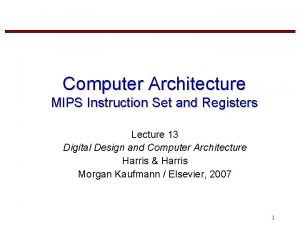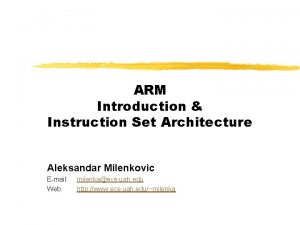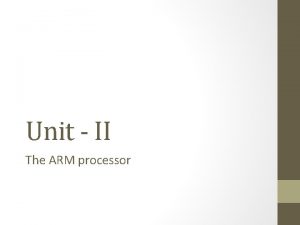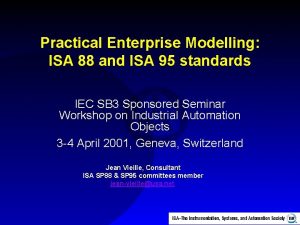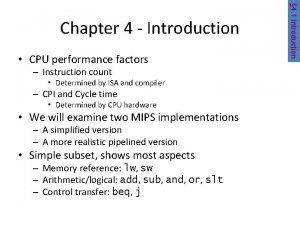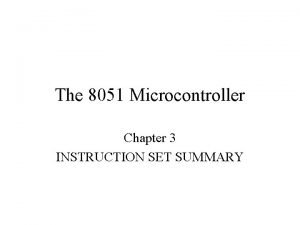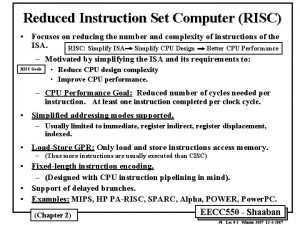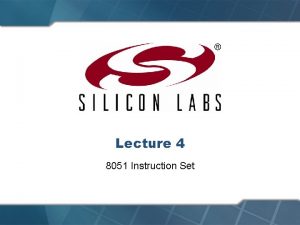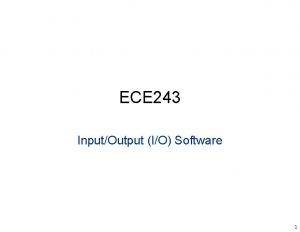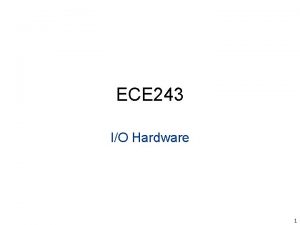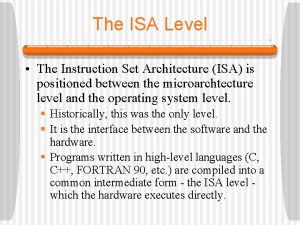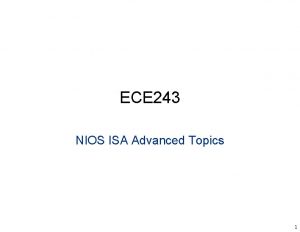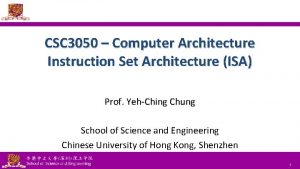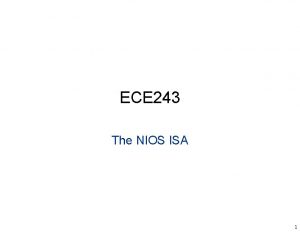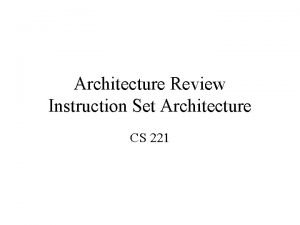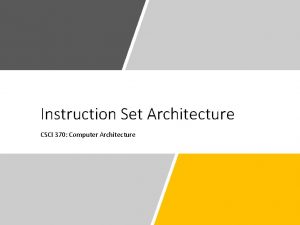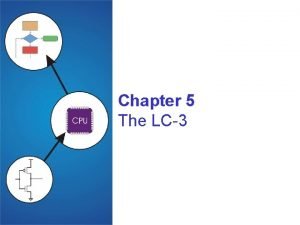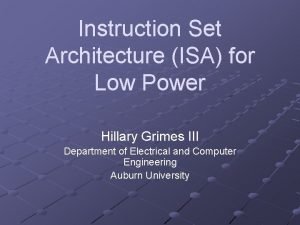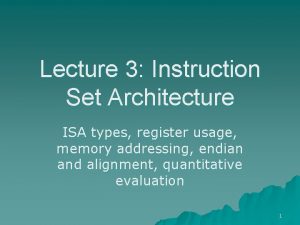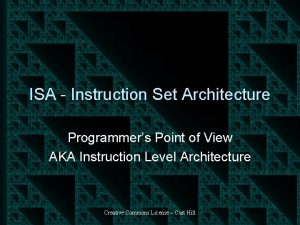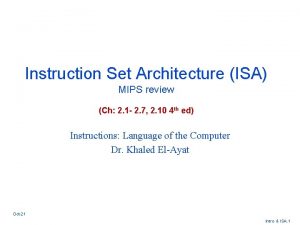ECE 243 ISA Instruction Set Architecture 1 A






















- Slides: 22

ECE 243 ISA: Instruction Set Architecture 1

A TYPICAL PC Graphics card Motherboard (CPU, MEMORY) Hard drive CD/DVD R/W Monitor USB Connectors Keyboard Mouse Power Supply 2

Simple View of a Motherboard Memory (RAM) BUS CPU • Memory: – holds bits – can be read from or written to • BUS: – A collection of wires connecting two or more things • CPU: – datapath: arithmetic/logic units (add, sub), muxes, etc. – control circuitry 3

GOALS OF A COMPUTER SYSTEM • To process digital information – read data from memory, process by the CPU, write to memory – or from/to some other I/O device • To be programmable – can change how the CPU processes – CPU “executes” a program – Program is a collection of instructions – Each instruction is encoded as a group of bits, stored in memory 4

INTERFACE & IMPLEMENTATION • Example: Cars 5

INTERFACE & IMPLEMENTATION • CPUs: – interface: • ISA: instruction set architecture: • defines “machine instructions”: groups of bits – implementation: • design of the CPU (datapath and control) • the logic and wires that execute machine instructions 6

Real Life ISAs • Companies invent/license their own ISAs • Examples: – Intel: IA 32 (aka x 86), IA 64; IBM: Power. PC; SUN: SPARC – NOTE: x 86 designed in 70’s for CPUs with 2 k transistors! – Motorola: 68000 (aka 68 k), Altera NIOS II (MSL/243) • How can the Pentium IV run programs written for the Pentium II? 7

THE BASIC CPU CYCLE • Forever: 1. Fetch Instruction from Memory 2. Read Input Operands 3. Execute (calculate) 4. Write Result 5. Determine Next Instruction • How does CPU know where the next inst is? – – Program counter: Called the PC Internal to the CPU Holds the memory address of the next instruction 8

Simplified Example 1. Fetch Instruction from Memory 2. Read Input Operands 3. Execute (calculate) 4. Write Result 5. Determine Next Instruction (PC = PC + 4) CPU: Memory: 0 x 2000: add a, b, c 0 x 2004: sub b, a, a 0 x 2008: add b, c, b PC: 0 x 2000 a: 5 ALU b: 7 c: 0 9

ECE 243 Accessing Memory 10

“Von Neumann” Memory Model Memory (RAM) BUS CPU Instrs, Data • Instrs and data both reside in a memory – Note: instrs and data are both just bits • but interpreted differently 11

MEMORY OPERATIONS • Load: – CPU provides an address – MEM returns value from that location • Store: – CPU supplies address and value – MEM updates that location with the value • A C-code analogy – char MEM[size]; // byte-sized elements – A load: – A store: 12

MEMORY ADDRESSES • A number – an index into the giant memory array – enough bits in number to index every memory location • Address space: – the space of possible addresses for a memory – b = #bits to represent the address space, size = 2 b • EX: how big is a 32 -bit address space? 13

MEMORY GRANULARITY • How much data is in each memory location? – usually one byte per location – such a machine is called “byte-addressable” • EXAMPLE (assuming byte addressable) – Loadbyte A, 0 x 20 – Storebyte 0 x 23, A 0 x 20 5 0 x 21 6 0 x 22 7 0 x 23 8 14

Bits and Bytes Terminology LS-bit MS-bit 1 0 0 1 • LS-Bit: least-significant bit • MS-Bit: most-significant bit MSB 10101001 LSB 010010101011 10001100 • LSB: least-significant byte • MSB: most-significant byte 15

ENDIAN • In What order do we load/store the bytes of a multi-byte value? – Depends whether processor is: • “big endian” or “little endian” • Big Endian: – load/store the MSB first • i. e. , in the lowest address location • Little Endian: – load/store the LSB first • i. e. , in the lowest address location • There is no superior endian! – “Gullivers Travels” 16

Endian Matters When: 1) You store a multi-byte value to memory 2) Then you load a subset of those bytes Different endian will give you different results! Different processors support different endian – – – Big endian: motorola 68 k, Power. PC (by default) Little endian: intel x 86/IA-32, NIOS Supports both: Power. PC (via a mode) Eg: must account for this if you send data from big. E machine to a little-E machine 17

EXAMPLE: ENDIAN unsigned int a = 0 x 0000; unsigned int b = 0 x 11223344; unsigned int c = 0 x 55667788; • Assume: ‘a’ starts at addr 0 x 20000 • Conceptual View: (same for little or big endian) Addr Value 0 x 20000 0 x 0000 a 0 x 20004 0 x 11223344 b 0 x 20008 0 x 55667788 c 18

EXAMPLE: LITTLE ENDIAN unsigned int a = 0 x 0000; unsigned int b = 0 x 11223344; unsigned int c = 0 x 55667788; Detailed View: Addr Value 0 x 20000 0 x 20001 0 x 20002 a 0 x 20003 0 x 20004 0 x 20005 0 x 20006 b 0 x 20007 0 x 20008 0 x 20009 0 x 2000 a c 0 x 2000 b 19

EXAMPLE: BIG ENDIAN unsigned int a = 0 x 0000; unsigned int b = 0 x 11223344; unsigned int c = 0 x 55667788; Detailed View: Addr Value 0 x 20000 0 x 20001 0 x 20002 a 0 x 20003 0 x 20004 0 x 20005 0 x 20006 b 0 x 20007 0 x 20008 0 x 20009 0 x 2000 a c 0 x 2000 b 20

EX: store 0 x. A 1 B 2 C 3 D 4 to addr 0 x 20 Big Endian Little Endian Addr Value 0 x 20 0 x. A 1 0 x 20 0 x. D 4 0 x 21 0 x. B 2 0 x 21 0 x. C 3 0 x 22 0 x. B 2 0 x 23 0 x. D 4 0 x 23 0 x. A 1 Load 4 B at 0 x 20: Load 2 B at 0 x 22: Load 1 B at 0 x 21: 21

Endian: Punchline • Endian: a tricky detail of computer systems – can cause big headaches if you forget about it • In labs and exams: – be careful not to forget about endian! • Recall: endian matters when: 1) You store a multi-byte value to memory 2) Then you load a subset of those bytes 22
 Instruction set architecture
Instruction set architecture Marie instruction set architecture
Marie instruction set architecture Mips instruction set architecture
Mips instruction set architecture Implement carry arbitration encoding in arm9tdmi
Implement carry arbitration encoding in arm9tdmi Which instruction set architecture is used in beaglebone
Which instruction set architecture is used in beaglebone Instruction set architecture
Instruction set architecture Instruction set architecture
Instruction set architecture Instruction set architecture in computer organization
Instruction set architecture in computer organization Mips code
Mips code Total set awareness set consideration set
Total set awareness set consideration set Training set validation set test set
Training set validation set test set What is the difference between isa 88 and isa-95?
What is the difference between isa 88 and isa-95? Infrasternal angle
Infrasternal angle Instruction count is determined by isa and cpu hardware.
Instruction count is determined by isa and cpu hardware. Differentiated instruction vs individualized instruction
Differentiated instruction vs individualized instruction Direct instruction vs indirect instruction
Direct instruction vs indirect instruction Cbw 8086
Cbw 8086 Little man computer
Little man computer Instruction set of 8051
Instruction set of 8051 Computer sic
Computer sic Apa itu set instruksi
Apa itu set instruksi Zero instruction set computer
Zero instruction set computer Clr a instruction in 8051
Clr a instruction in 8051


